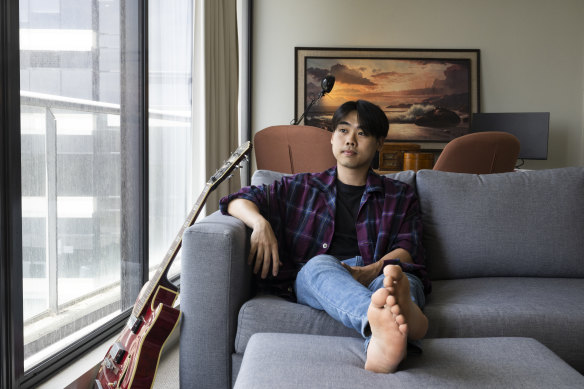This was published 1 year ago
Editorial
Sydney’s overcharged approach the end of their tether
Sydney’s housing crisis is too often viewed through the lens of buying affordability rather than the impact the crunch is having on rents and renters.

Ayaki Ito at his St Leonard’s apartment.Credit: Louise Kennerley
Renters always take the back seat to buyers. In our worlds of dreams and reality, it is no accident that the multimillion-dollar sale of a home in Sydney’s eastern suburbs is invariably celebrated while the discovery of a desirable and affordable rental property passes unheralded.
The grim reality for renters in Sydney is that there are no bargains left. They are paying through the nose for the property boom. Sydney house rents have soared to new heights, jumping by $100 a week in some areas in just three months.
The Herald’s report on St Leonards marketing worker Ayaki Ito illustrates the daunting experience renting in Sydney: he copped a 33 per cent rent increase on his one-bedroom unit, after two hikes, from $420 to $460, then $560 a week. Unit rents in the suburb increased 26.9 per cent year-on-year. And if there is another rise, the 27-year-old is reluctantly prepared to return to share housing.
Sydney’s median house rent has reached a record of $730 a week, rising 1.4 per cent over the December quarter and 12.3 per cent over the year, the latest Domain Rent Report, released on Thursday shows. Rents are now 40 per cent higher than in December 2019. In the apartment market, median asking rents held flat over the quarter, at a high of $680, after two-and-a-half years of growth – ending the longest stretch of Sydney rent rises on Domain records. The median was up 17.2 per cent year-on-year and 33 per cent since December 2019.
According to the Australian Bureau of Statistics, 31 per cent of 10.4 million households pay rent for their residences around the nation. In NSW, renters now top 2 million and their numbers are likely to grow while homeownership remains out of reach for many due to affordability and the pressure being exerted on supply by a roaring economy and population increase. Last month, for instance, the city’s vacancy rate reached just 1.3 per cent.
Federal and state governments are attempting to solve the supply issue with renewed targets for more new homes and affordable housing and a plan to review short-term rental accommodation, identifying as many as 90,000 homes that could be lured back onto the long-term rental market.
As reports of homelessness, vaulting rents, interest rate rises and the inability of younger generations to buy dominate the headlines, NSW Premier Chris Minns deserves credit for attempting to tackle the housing crisis, even putting councils on notice, warning that planning consent powers would be removed and handed to the Planning Department if there was continued failure to meet a housing target of constructing 76,000 new homes a year for five years.
Meanwhile, AMP chief economist Shane Oliver predicted Sydney rents will continue to climb, forecasting 5-7 per cent annual growth. “It does seem as if momentum is cooling, reflecting cost of living pressures, possible signs that rental demand might be slowing and the market being up against affordability constraints. Wages have not been keeping up with the cost of living … so the ability of renters to pay higher and higher rents is somewhat limited,” he said.
Sydney’s property boom and bank policies now restrict home or unit ownership to the well-paid or those with well-heeled parents. But for many renters, the housing crisis is not about living the Australian dream but just getting by. Reforms are coming, but if the increases keep coming, the question facing NSW is how many renters will take to the streets before help arrives?
Bevan Shields sends an exclusive newsletter to subscribers each week. Sign up to receive his Note from the Editor.
correction
An earlier version of this story said that 31 per cent or 9.8 million households pay rent for their residences around the nation according to the Australian Bureau of Statistics. This has been corrected to say 31 per cent of 10.4 million households.